The hardware specifications of smartphones have slowed down, and mobile phone manufacturers have begun to shift their focus to more intelligent functions and enhanced user experience. The mobile phone industry generally believes that situational awareness and biometrics will be the next major development trend, and future mobile phones will also Will have a more complete machine learning function, according to the consumer's use of the situation to adapt.
In the past, smartphone manufacturers are accustomed to introducing the latest processors, panels, cameras and other technologies in the flagship models. The differences in products are limited. However, in the past two years, some mobile phone brands are no longer pursuing top hardware specifications, but instead focus on Enhance the user experience, trying to attract consumers with humanized software features, but the results are different.
From the development trend of this year's Global Mobile Communications Conference (MWC 2015), the next main battlefield of smartphones will be context-aware computing combining various sensors, as well as more advanced biometric functions such as fingerprint recognition and face recognition. .
According to TIm McDonough, vice president of marketing at Qualcomm, many people often feel that the new smartphone is not much different from the previous one. It may be faster, such as faster LTE and faster Wi-Fi. A more optimized central processing unit (CPU) and image processing unit (GPU), but its industry should provide consumers with higher expectations. The next generation of smart phones can be more interesting and bring new and different users. Experience.
If the processor of the intelligent machine has the machine learning function, it can recognize objects, people or corresponding scenes, and combine the built-in sensors of the smartphone, such as touch, angle, height, temperature, optics, etc. The data collected by the sensor is analyzed and learned, and then the corresponding judgment is made, so that the user can obtain more intimate use experience.
For example, he said that if the mobile phone has advanced image recognition capabilities, it can determine the type of scene and the whole environment through the camera, whether it is indoor or outdoor, sunrise or sunset, and can classify the photos, such as buildings, people, Beaches, children, trees, watches, etc., to provide better photo effects and even other intelligent features for different themes or objects.
In addition, the mobile phone can also recognize handwritten notes and automatically convert them into text, and has intelligent learning functions. For example, through a continuous running platform, voice and audio can be recognized, and the user's instructions can be waited at any time to identify the surrounding. Background sound, or automatically recognize music songs, no need to unlock, open recognition software and other programs.
In fact, Qualcomm has planned to integrate the Zeroth cognitive computing platform for the first time in the new generation of Snapdragon 820 processors, so that mobile phones can sense the surrounding things, and it has a variety of mobile experience and cognitive computing capabilities, including computer vision, machines. The visual perception of a smart lens that learns, recognizes situations, and reads text and writing.
Combine the sensing engine, sensing fusion, machine learning, resolution algorithm, and the full-time environment sensing capability that can sense the environmental changes and predict the user's needs at any time. The radio signal, sound source localization, sound discrimination, natural Language processing, which recognizes the speech recognition ability of environmental audio, music or vocals, and recognizes the natural device interaction ability of gestures, expressions and faces.
CrisTIano Amon, executive vice president and QCT co-president of Qualcomm Technology, said that mobile devices have increasingly sophisticated computing, multimedia and networking capabilities, and will surpass traditional functions in the future, becoming a tool for learning and responding to user needs. It will be extended to a series of products such as smartphones, automobiles, and wearable devices, so that different terminal devices can have such intelligent and personalized functions.
McDonough stressed that I don't want the smartphone industry to be like the PC industry. Because the PC change cycle is very long, almost all of them can't be used until the PC can be used. I hope that the smart phone industry will show a passionate development trend. Mobile phone manufacturers and software developers can create more innovative value and growth momentum on the basis of it.
8 Layer PCB - Stackup & Cost & Prototype manufacture
What is 8 layer PCB?
The 8 layer PCB is a circuit board with 8 layers that are stacked firmly together with predefined and dependable mutual connections between the layers. Structure of eight layer PCB is more complicated. Nowadays, PCBs frequently have 8 to 12 layers or more, and electronics engineers know that designing for so many layers requires a well-configured layer stack.
8-layer Printed Circuit Boards are usually installed in compact equipment with strict spacing requirements, such as notebook computer motherboard, communication backplane, wearable watches, etc. Because of its complexity and high manufacturing costs, your 8-layer PCB Manufacturing should be made by reliable and experienced manufacturers. Jinghongyi PCB has been specially targeting high-end PCB manufacturing and assembly services for 8 years, providing high-quality products and services for various customers. Our advanced production line and fast response team will keep you comfortable and reassured, without any trouble, you can rest assured to place the order with us.
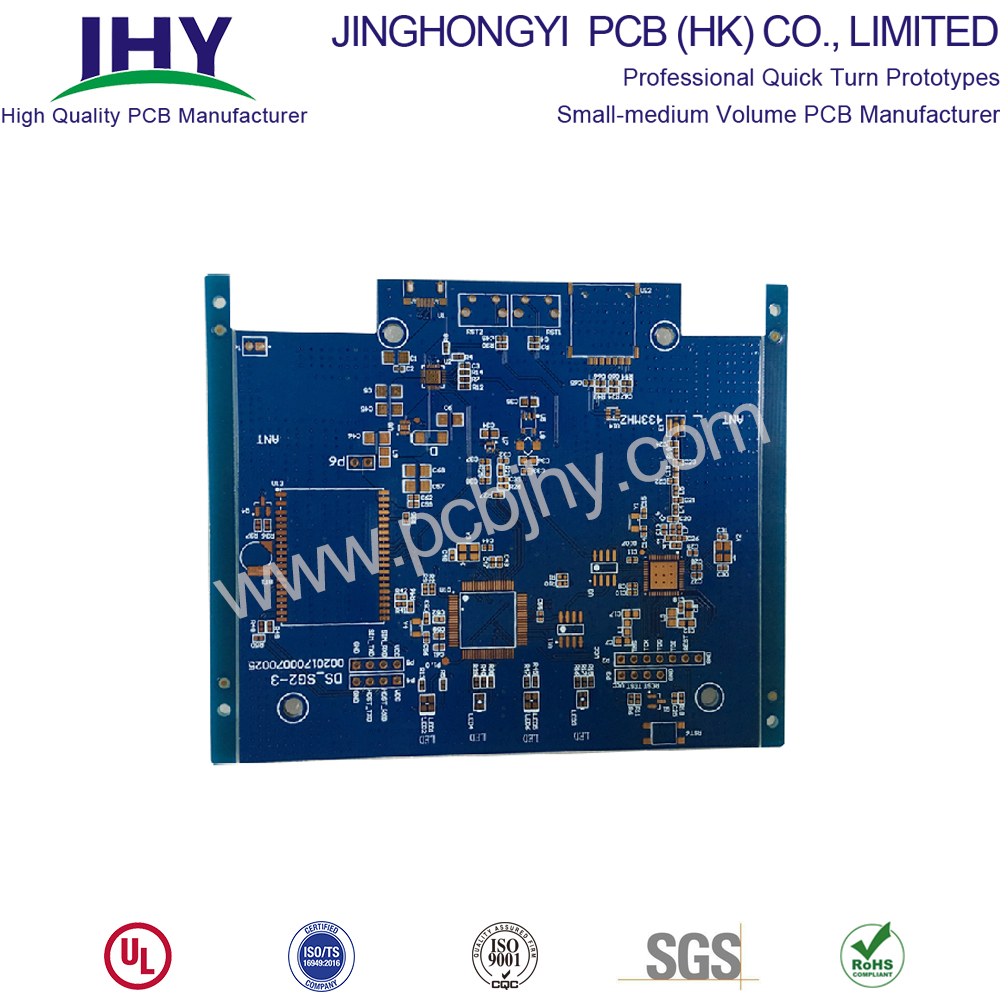
Typical 8-layer PCB stack up methods and guidelines
Standard stackup of 8 layer PCB looks as follows
- Signal1
- Ground
- Signal2
- Power
- Ground
- Signal3
- Power
- Signal4
Eight-layer PCB can be used to add two additional layers, or two planes can be added to improve EMC performance. Most eight-layer circuit boards are superimposed to improve EMC performance, rather than adding additional wiring layers. Compared with 6-layer circuit boards, the cost increase percentage of 8-layer PCB is less than that of 4-layer PCB to 6-layer PCB. Therefore, in order to improve EMC performance, the cost increase is reasonable. Therefore, most 8-layer boards consist of four wiring layers and four planes.
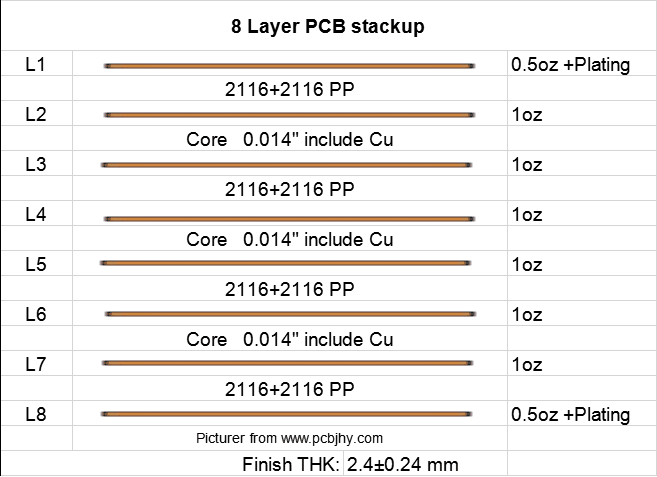
8 Layer PCB Stack up
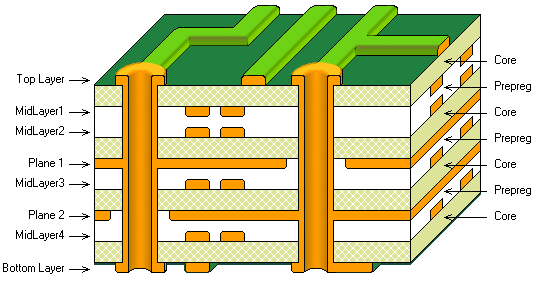
8 Layer PCB stackup
In short, 8 layer PCB are usually used to improve the EMC performance of circuit boards, rather than increasing the number of layers.
No matter how you decide on the stack layer, it is not recommended to use an 8-layer PCB Board with six wiring layers. If you need six routing layers, you should use a 10 Layer PCB board. Therefore, the 8-layer board can be regarded as the six-layer board with the best EMC performance.
Basic Layer of Eight-Layer Circuit Board with Excellent EMC Performance
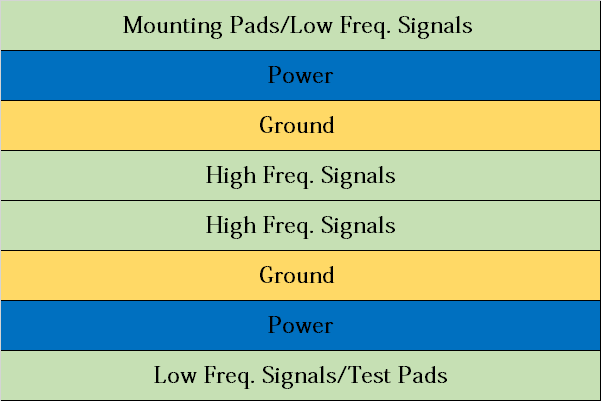
All signal layers are adjacent to the plane, and all layers are tightly coupled. High-speed signals are buried between planes, so planes provide shielding to reduce the transmission of these signals. In addition, the circuit board uses multiple grounding layers to reduce the grounding impedance.
Other forms of 8-layer PCB stackup
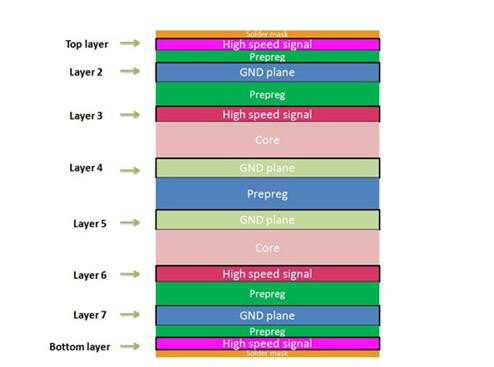
A typical 8 Layer PCB Stackup
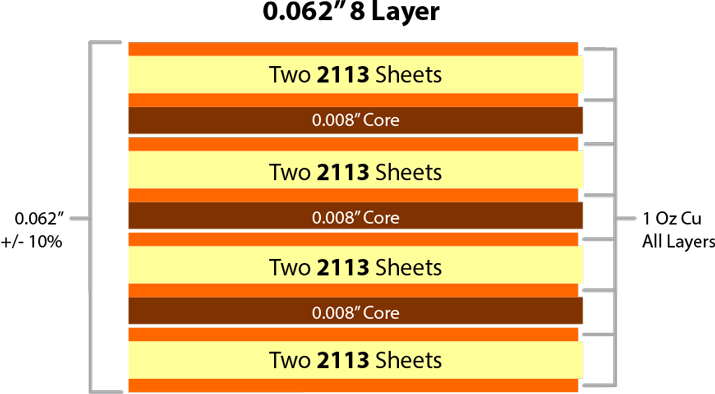
0.062[8 layer PCB stackup
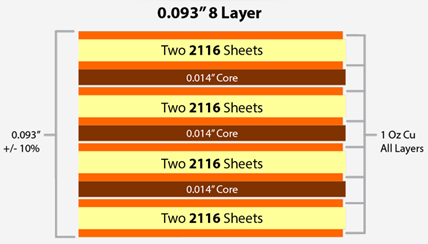
0.093[ 8-Layer PCB Stackup
So far, we have also clarified the cost and price differences between 6-layer PCB, 8-layer PCB and 10-layer PCB.
8 Layer PCB thickness
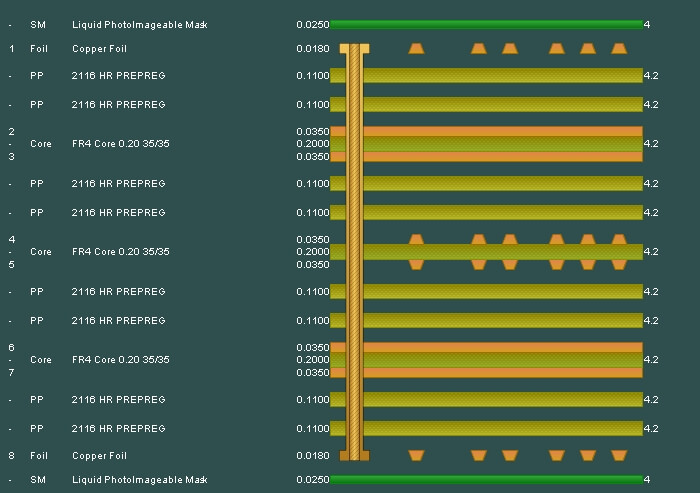
8 LAYER 1.6 MM STANDARD STACKUP AND THICKNESS
8 Layer Stackup - 1.6mm thickness |
||||||
| layer order | layer name | material type | material description | dielectric constant | thickness | copper weight |
| 1 | top | copper | signal | 0.035mm | 1 oz | |
| 2116 | prepreg | 4.5 | 0.12mm | |||
| 2 | inner 1 | copper | plane | 1 oz | ||
| core | 4.6 | 0.3mm | ||||
| 3 | inner 2 | copper | plane | 1 oz | ||
| 7630 | prepreg | 4.7 | 0.2mm | |||
| 4 | inner 3 | copper | plane | 1 oz | ||
| core | 4.6 | 0.3mm | ||||
| 5 | inner 4 | copper | plane | 1 oz | ||
| 7630 | prepreg | 4.7 | 0.2mm | |||
| 6 | inner 5 | copper | plane | 1 oz | ||
| core | 4.6 | 0.3mm | ||||
| 7 | inner 5 | copper | plane | 1 oz | ||
| 2116 | prepreg | 4.5 | 0.12mm | |||
| 8 | bottom | copper | signal | 0.035mm | 1 oz | |
| Final board thickness: 1.6mm±0.13mm | ||||||
8-Layer Prototype PCB Manufacturing Service
The 8-layer prototype FR-4 PCB is an 8-layer circuit board, which is firmly stacked together with predefined and reliable interconnection between layers. The 8-layer FR-4 PCB has more complex structure. JHYPCB is a large enterprise located in Shenzhen, China, which can manufacture 8-layer prototype PCB.
JHYPCB can provide you with multi-layer PCB board in accordance with RoHS standard. With laminated material, it can match high temperature in assembly process. Importantly, some lead-free assembly processes will require laminated substrates to withstand temperatures exceeding 260 degrees Celsius or 500 degrees Fahrenheit over a longer period of time. To solve this problem, we have high temperature laminates in stock, so that our customers can meet the higher temperature cycle requirements of some lead-free assembly applications.
JHYPCB is one of the leading 8 layer PCB manufacturers. For more information, pls send email to us.
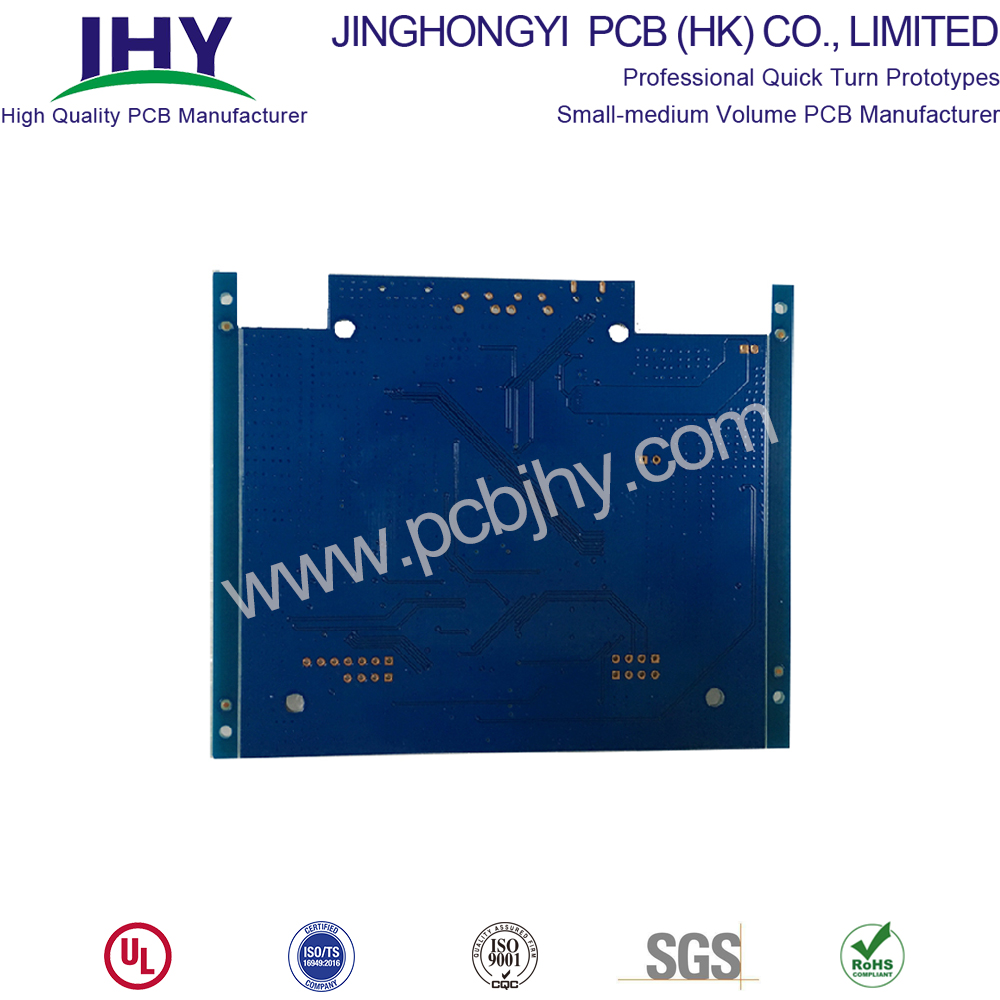
8 Layer PCB
PCB Circuit Board,8 Layer PCB,Custom multilayer pcb,Custom 8 Layer PCB
JingHongYi PCB (HK) Co., Limited , https://www.pcbjhy.com